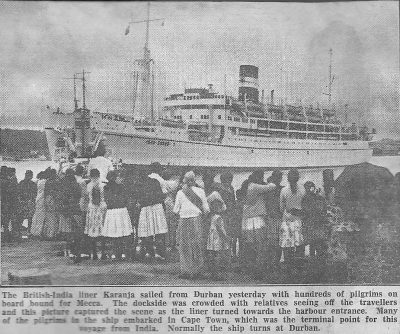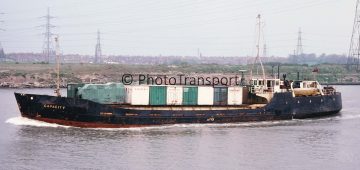From: Bob Swanton, Melbourne, Australia
Could any shipbuilder match the impregnability and longevity of Barclay Curle’s “Edina”?
On reading Norman Middlemiss’ excellent article on the Currie Line of Leith in November’s ST&Y and his reference to the Leith, Hull and Hamburgh Steam Packet Company’s “Edina” (380/1854) it brought to mind the quality workmanship of her builders, Barclay, Curle & Co Ltd.
Edina, an iron steamer of three masts, with yards to carry sails when wind conditions were suitable, was sold by LHHSP after around nine years of Continental service, to interests in Australia. After sailing the 12,000 mile voyage to Melbourne, Edina was engaged for some years in serving ports on the Victorian coast.
Then in 1875, Wm Howard Smith purchased the vessel to open up trade between Sydney and Queensland coastal ports.(Wm Howard Smith was the founder of Howard Smith Ltd. which more than 100 years later acquired the towage business of Alexandra Towing Co., JP Knight and others to become the largest tug owner in the UK. Several years later in 2001 it sold the business to another Australian tug operator, Adsteam Marine, which in turn was taken over by SvitzerWijsmuller in 2007). Subsequently, after her Queensland service, Edina returned to Victoria and was refitted for the busy Port Phillip Bay passenger service connecting settlement ports with Melbourne.
It was during this time that her hull and overall structure were fully tested. She had the dubious distinction of colliding with and sinking not one vessel but three – not all at once it must be said! In April 1898, Edina collided with and sank the Manawatu (183/1873) owned by Union SS Co of NZ Ltd., the following year she collided with and sank the Excelsior (340/1882) owned by Huddart Parker & Co Pty Ltd. Finally, Edina in July 1928,collided with and sank the steamer Hovell (46/1918) owned by the Melbourne Harbour Trust. Such was the solid structure of Edina that she continued unabated from these mishaps until in 1938 she was withdrawn from passenger service. At that time she was described as the oldest passenger vessel in regular service in the world.
Edina was then sold by Howard Smith and converted into a lighter, again serving the Melbourne waterfront until at 104 years of age she was sold for demolition and beached at Coode Island in the Maribyrnong River, Melbourne in 1958. Thus ended the career of a remarkable vessel; one cannot but wonder, if John Barclay, one of the owners of LHHSP in the early 1850’s, asked his shipbuilding brother at Barclay Curle & Co for a special “family deal” in terms of quality construction! Nevertheless, the record of Edina is great testimony to the quality output of Barclay Curle & Co. (Acknowledgement should be made to Ian Farquhar and the late Robert Tomkins for the information in their books “Howard Smith Shipping”, “ Union Fleet” and “Compendium of Australasian Merchant Ships”, respectively.)
As an aside, Edina for her first 50 years in Australian waters would have sailed by or berthed in the vicinity of vessels of another Currie Line. Founded by Archibald Currie, born in the UK, like his namesake but unrelated Sir Donald Currie, or his brother James Currie who both developed LHHSP into the large Currie Line of Leith, Archibald who migrated to Australia in 1852 grew his shipping line to become the Currie Line of Melbourne. This line became a significant player in developing the Australia to India liner service. Following Archibald Currie’s death in 1910 the Australia/India rights plus the fleet were sold in 1913 to Lord Inchcape’s British India Steam Navigation Co., the major British line in the trade. (Reference: “The Currie Line of Melbourne” – author, the late WA Laxon).

From: Henry Aiken, by e-mail
Thank you for the articles on the above ships. I lived in Durban when these liners called at the port and it was always an occasion when these ships arrived specially for ship lovers. I knew one of the radio officers on the Karanja and always went on board when the ship was in port. The ships nearly always berthed at the passenger terminal, which is on the seaward side of the harbour and not the esplanade side of the harbour. Before the passenger terminal was built the ships berthed at A shed which was just behind where the Union Castle liners berthed.
Above is a press photo of the Karanja taken when she left Durban in 1963 having been to Cape Town to embark pilgrims bound for Mecca. The cargo liners of BI were infrequent callers to Durban but that all changed when the Suez canal was closed. Chilka being the last ship to load and sail from the UK to Africa. She arrived in Mombasa on 14/06/1972 and then made her way to the breakers. When the Suez canal closed for the second time the P&O liners were regular callers at Durban, bunkers were cheaper in Durban. It was quite an occasion in November 1970 when the QE 2 made her maiden call at Durban as the Oronsay was also in port. In January 1973 the Oronsay called at Durban on her way to the breakers. She was berthed at Island View rather an out of the way place for a large passenger liner. The Orsova called for bunkers in January 1974 on her way to the breakers but was berthed at the passenger terminal, a more suitable place. I managed to take slides of these ships on their way to the breakers. Sadly we will never see their likes again.

From: Michael Waterman, by e-mail
Thank you for the interesting memorable ships Orcades, Oronsay & Orsova in issue 312 February 2016.
The article states that when Orcades became one class her 1st Class Restaurant was converted into a cinema. That was not the case. The Grill Room on A Deck was converted into a cinema. The Grill Room was a feature of the Orient Line vessels being a facility that offered 1st Class passengers a more relaxed surrounding than the main saloon. It was also air conditioned and had a kitchen. P&O Liners did not have facility and so when the two companies became one the Grill Room had to go. Another difference between Orient Line and P&O was the crew. Orient employed all European crew including engineroom hands where as P&O had European, Goanese stewards, Indian deck hands and Pakistani engineroom hands. When the two companies became one some Goanese crew members were introduced.






Comments
Sorry, comments are closed for this item